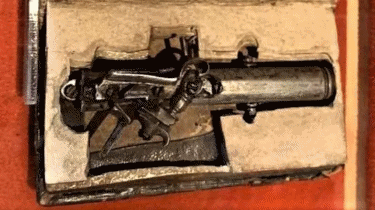After a thousand years stuck on a dusty library shelf, the oldest [Oldest Medieval MSS. There are a considerable number of fragments from Antiquity. -DZ] copy of Homer’s Iliad is about to go into digital circulation.
A team of scholars traveled to a medieval library in Venice to create an ultra-precise 3-D copy of the ancient manuscript — complete with every wrinkle, rip and imperfection — using a laser scanner mounted on a robot arm.
A high-resolution, 3-D copy of the entire 645-page parchment book, plus a searchable transcription, will be made available online under a Creative Commons license.
The Venetus A is the oldest existing copy of Homer’s Iliad and the primary source for all modern editions of the poem. It lives in Venice at the ancient Public Library of St. Mark. It is easily damaged. Few people have seen it. The last photographic copy was made in 1901. …
The idea is “to use our 3-D data to create a ‘virtual book’ showing the Venetus in its natural form, in a way that few scholars would ever be able to access,” says Matt Field, a University of Kentucky researcher who scanned the pages. “It’s not often that you see this kind of collaboration between the humanities and the technical fields.”
Venice is not the most convenient work site. All the gear had to come by boat and be carried or dragged up the stairs of the library. Built in the 1500s, the library has been renovated periodically, but its builders never envisioned a need for big lights, a motorized cradle, 17 computers or wireless internet.
The group set up shop in an upstairs room, using their own electrical cables and adapters to harness the library’s modest power resources. They covered the window overlooking the Piazzetta San Marco with a black sheet to keep out sunlight that could damage the manuscript. They placed the book, the size and weight of a giant dictionary, on a custom cradle that holds it steady, and turned the lights down low.
No more than four people were allowed in the room at one time, to keep down heat and humidity. The conservator turned each page with his hands and set it against a plastic bar, where light air suction held it in place. The barn doors covering the lights were flung open for the time it took the photographer to snap a shot with a 39-megapixel digital camera, a Hasselblad H1 medium-format camera with a Phase One P45 digital back. As each page was photographed, the classics scholar on duty in the hallway outside the workroom would examine its image to make sure all the text was legible.
Then Field scanned each page to create a 3-D image. Using an ordinary flatbed scanner was out of the question — it would flatten the delicate parchments. So Brent Seales, a computer scientist from the University of Kentucky’s Center for Visualization and Virtual Environments, decided to use a laser scanner on a robot arm to make a 3-D scan of the pages.
Passing about an inch from the surface, the laser rapidly scanned back and forth, painting the page with laser light. The robot arm knows precisely where in space its “hand” is, creating a precise map of each page as it scans. The data is fed into a CAD program that renders an image of the manuscript page with all its crinkles and undulations.
“The resolution yields millions of 3-D points per page,” Seales says.
To store the data, the team used a 1-terabyte redundant-disk storage system on a high-speed network. The classicists on duty backed up the data every evening on two 750-GB drives and on digital tape. Blackwell carried the hard drives home with him every night, rather than leave the data in the library.
The next step is making the images readable. The Venetus A is handwritten and contains ligatures and abbreviations that boggle most text-recognition software. So, this summer a group of graduate and undergraduate students of Greek will gather at the Center for Hellenic Studies in Washington, D.C., to produce XML transcriptions of the text. Eventually, their work will be posted online for anyone to search, as part of the Homer Multitext Project.










